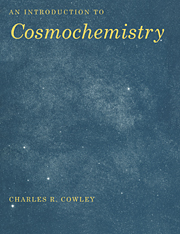Book contents
- Frontmatter
- Contents
- Foreword
- 1 Overview
- 2 Minerals: An Introduction to the Nomenclature and Chemistry
- 3 A Brief Introduction to Petrology
- 4 A Résumé of Thermodynamics and Statistical Mechanics
- 5 Condensation Sequences and the Geochemical Classification of the Elements
- 6 The Theory of the Bulk Composition of the Planets
- 7 Meteorites and the Standard Abundance Distribution (SAD)
- 8 An Introduction to Isotope Geology with an Emphasis on Meteorites
- 9 Some Concepts from Nuclear Physics
- 10 Energy Generation in Stars and Nucleosynthesis
- 11 Atomic and Molecular Spectra
- 12 The Analysis of Stellar Spectra
- 13 The Chemistry of Stars and Stellar Systems
- 14 Cold, Non-stellar Material in Galaxies
- 15 Emission-Line Regions and their Chemical Abundances
- 16 Abundances of the Elements in Galaxies
- Appendix
- References
- Index
3 - A Brief Introduction to Petrology
Published online by Cambridge University Press: 05 June 2012
- Frontmatter
- Contents
- Foreword
- 1 Overview
- 2 Minerals: An Introduction to the Nomenclature and Chemistry
- 3 A Brief Introduction to Petrology
- 4 A Résumé of Thermodynamics and Statistical Mechanics
- 5 Condensation Sequences and the Geochemical Classification of the Elements
- 6 The Theory of the Bulk Composition of the Planets
- 7 Meteorites and the Standard Abundance Distribution (SAD)
- 8 An Introduction to Isotope Geology with an Emphasis on Meteorites
- 9 Some Concepts from Nuclear Physics
- 10 Energy Generation in Stars and Nucleosynthesis
- 11 Atomic and Molecular Spectra
- 12 The Analysis of Stellar Spectra
- 13 The Chemistry of Stars and Stellar Systems
- 14 Cold, Non-stellar Material in Galaxies
- 15 Emission-Line Regions and their Chemical Abundances
- 16 Abundances of the Elements in Galaxies
- Appendix
- References
- Index
Summary
Preliminary Remarks
Petrology is the study of rocks. The prefix, petro, derives from a Greek word meaning rock, or stone. Those unacquainted with geology may be surprised to find that this subdiscipline of geology is huge. All aspects of the study of rocks are included. Not only are various rock types, their mineralogy and chemistry a part of petrology, but also the question of which rocks are where on the surface of the earth, and why. Cosmochemists, of course, must be concerned with lunar rocks and meteorites as well as their terrestrial congeners. Fortunately, lunar and meteoritic petrology are comparatively simple. A fundamental grasp of terrestrial igneous petrology will provide a good introduction to the study of extraterrestrial solids.
The three major divisions of terrestrial rocks are igneous, metamorphic, and sedimentary. Like all classifications these divisions have shortcomings. The boundaries are often ill-defined, and sometimes it is not particularly useful to place a rock in one category rather than another. Igneous rocks are those that have crystallized from a melt or magma. Geologists use the term magma to mean primarily liquid material, which may include some already solidified or not yet melted matter as well as dissolved or imprisoned gases. Lava, on the other hand, may be flowing, or long since frozen magma. Magma becomes lava when it erupts on the surface of the earth.
The signature of an igneous rock is usually evident from a freshly broken surface.
- Type
- Chapter
- Information
- An Introduction to Cosmochemistry , pp. 27 - 38Publisher: Cambridge University PressPrint publication year: 1995
- 1
- Cited by



